Ark matter in minimal 3-3-1-1 model
Abstract: In this work, we investigate a minimal SU SU U U (3) (3) (1) (1) C L X N ⊗ ⊗ ⊗ (3-3-1-1) model
and argue how it improves the phenomenological and theoretical aspects of the known minimal 3-3-1 model. The
lepton content includes only the standard model leptons, which form SU (3)L (anti)triplets, and the right-handed
neutrinos, which transform as SU (3)L singlets, in order to cancel the B L − anomalies. We show that the
electroweak and B L − interactions are unified, similarly to the electroweak theory, at the TeV scale. There is a residual symmetry of the gauge symmetry, called W -parity, which makes extra wrong B L − particles stabilized,
provides dark matter candidates.
Keywords: dark matter, standard model, 3-3-1-1 model, B L − anomalies, W - parity .
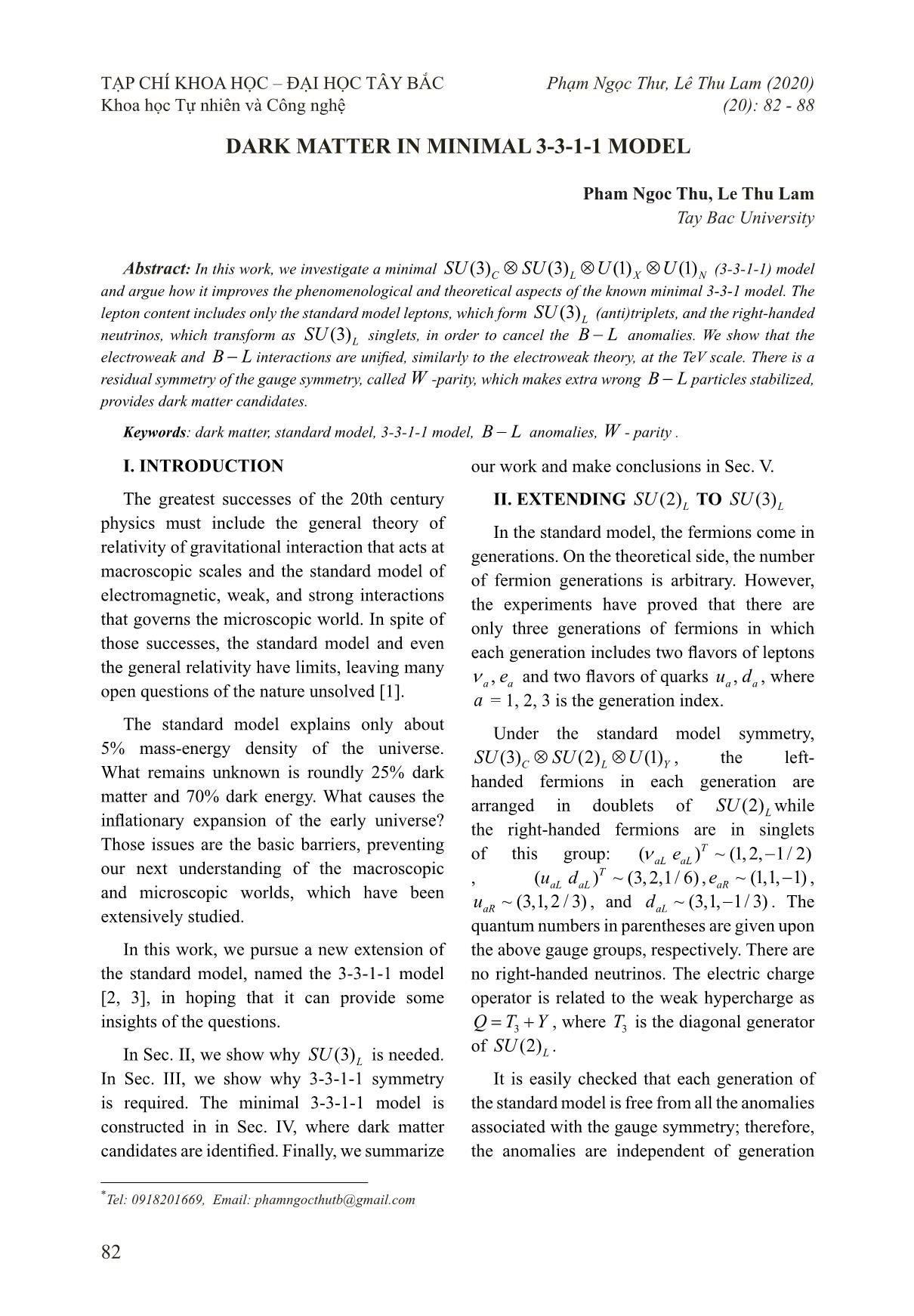
Trang 1
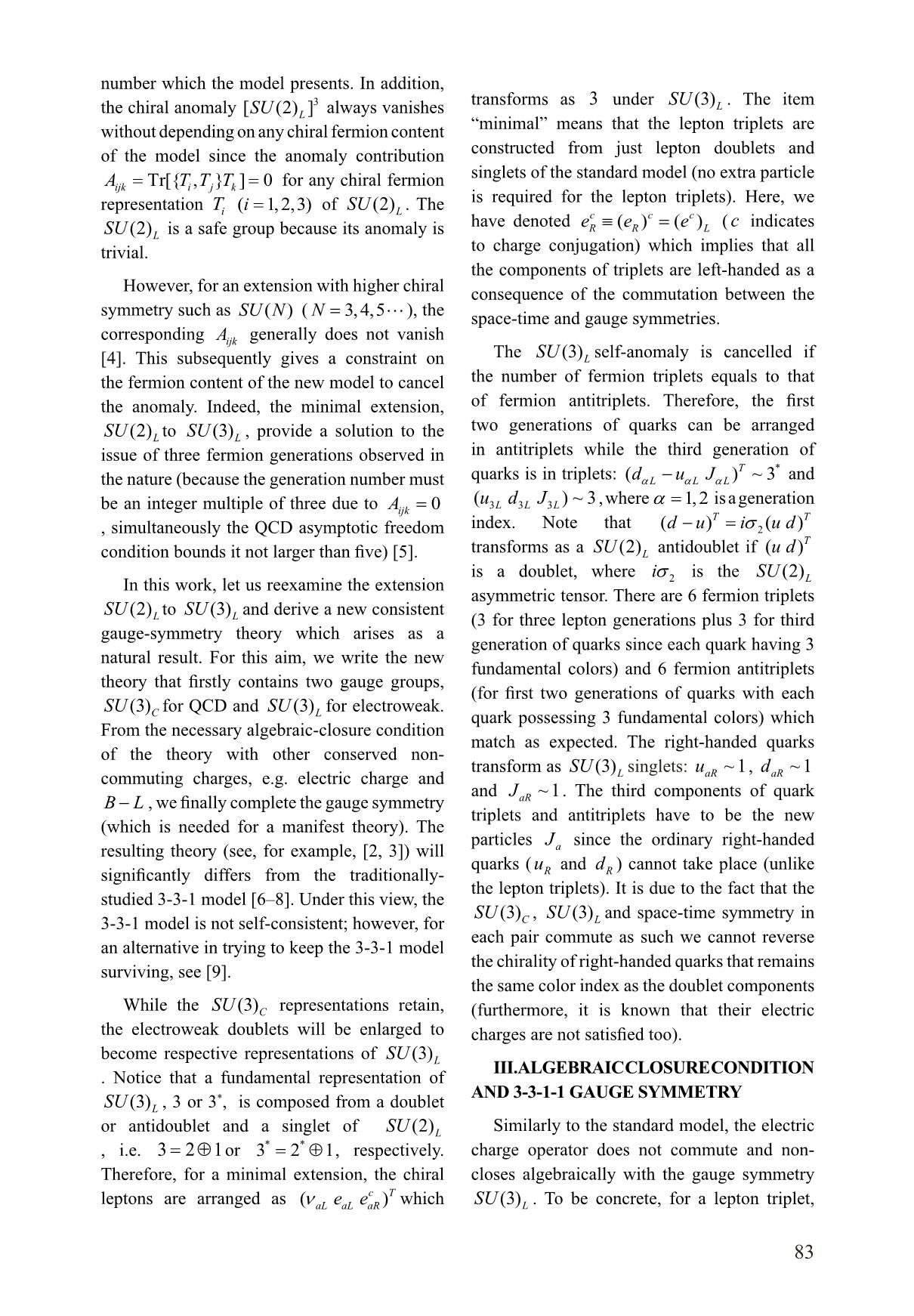
Trang 2
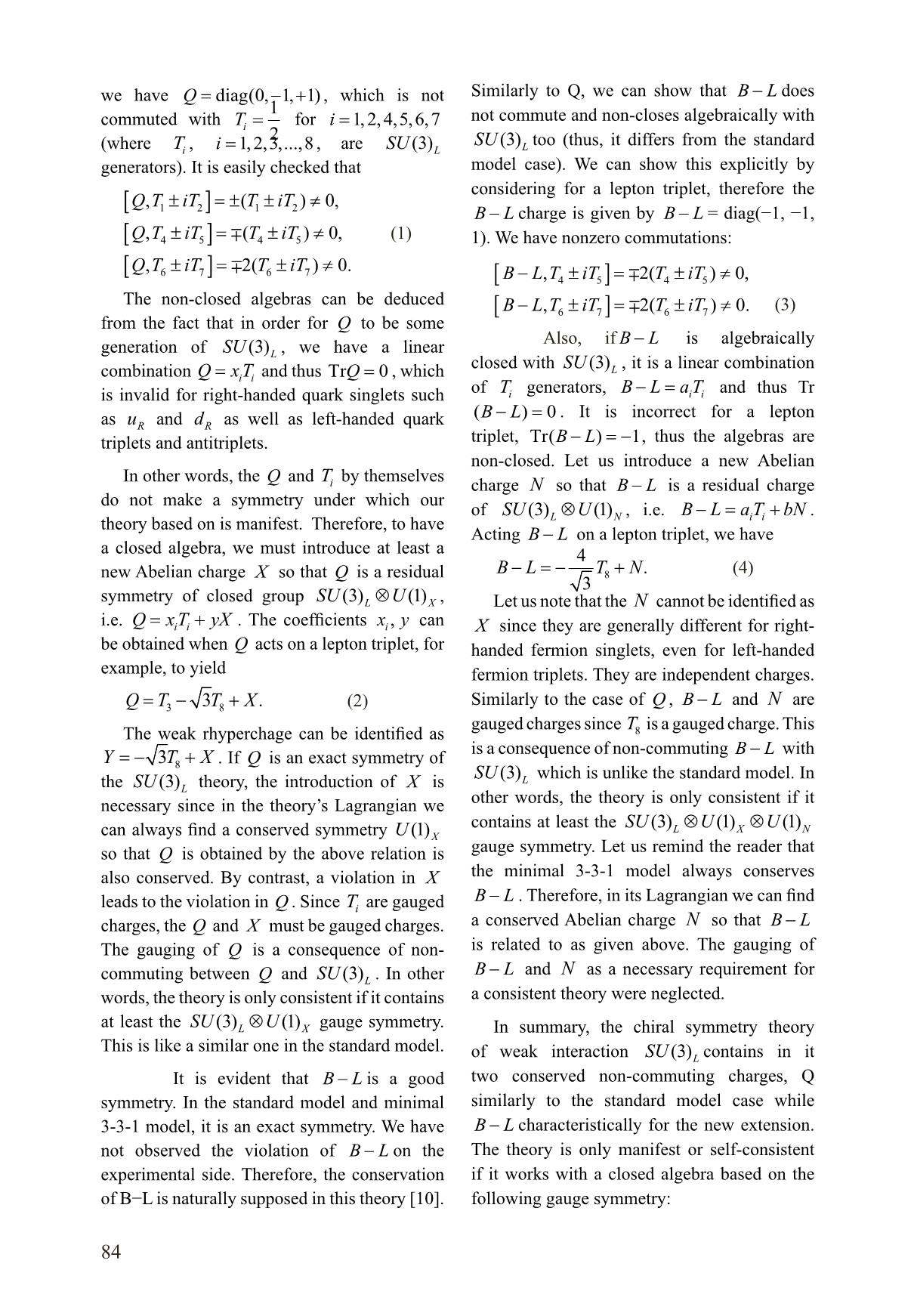
Trang 3
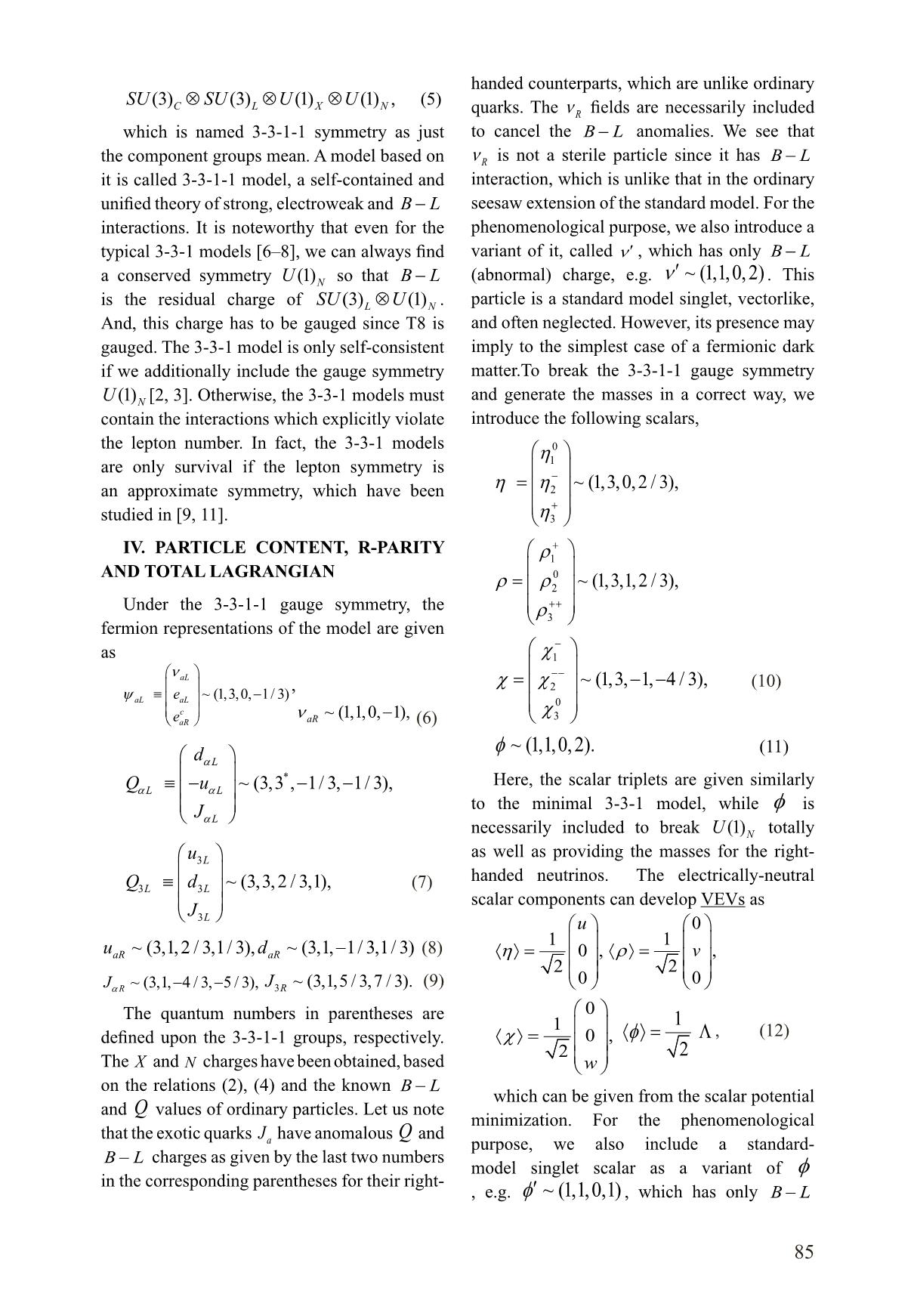
Trang 4
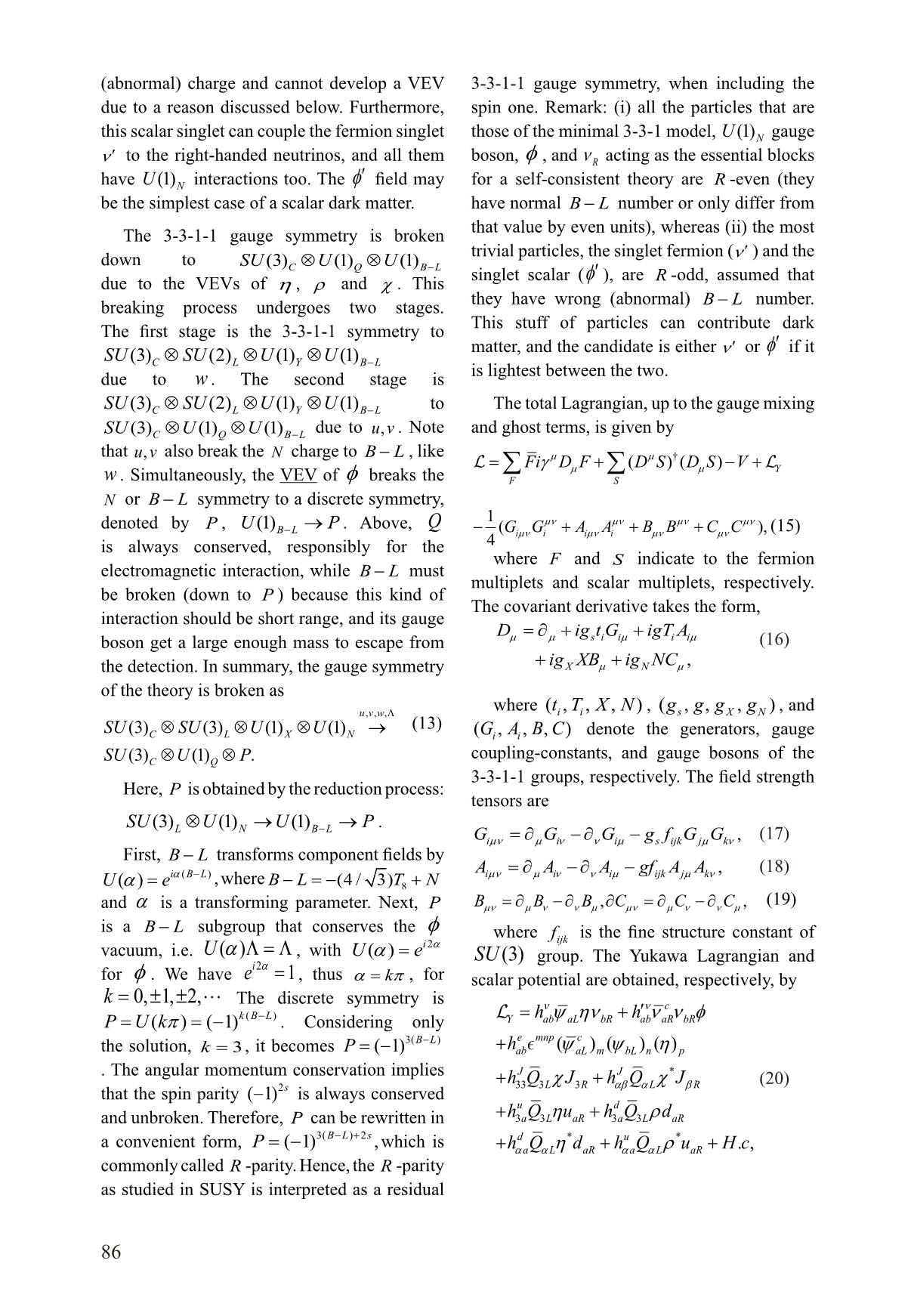
Trang 5
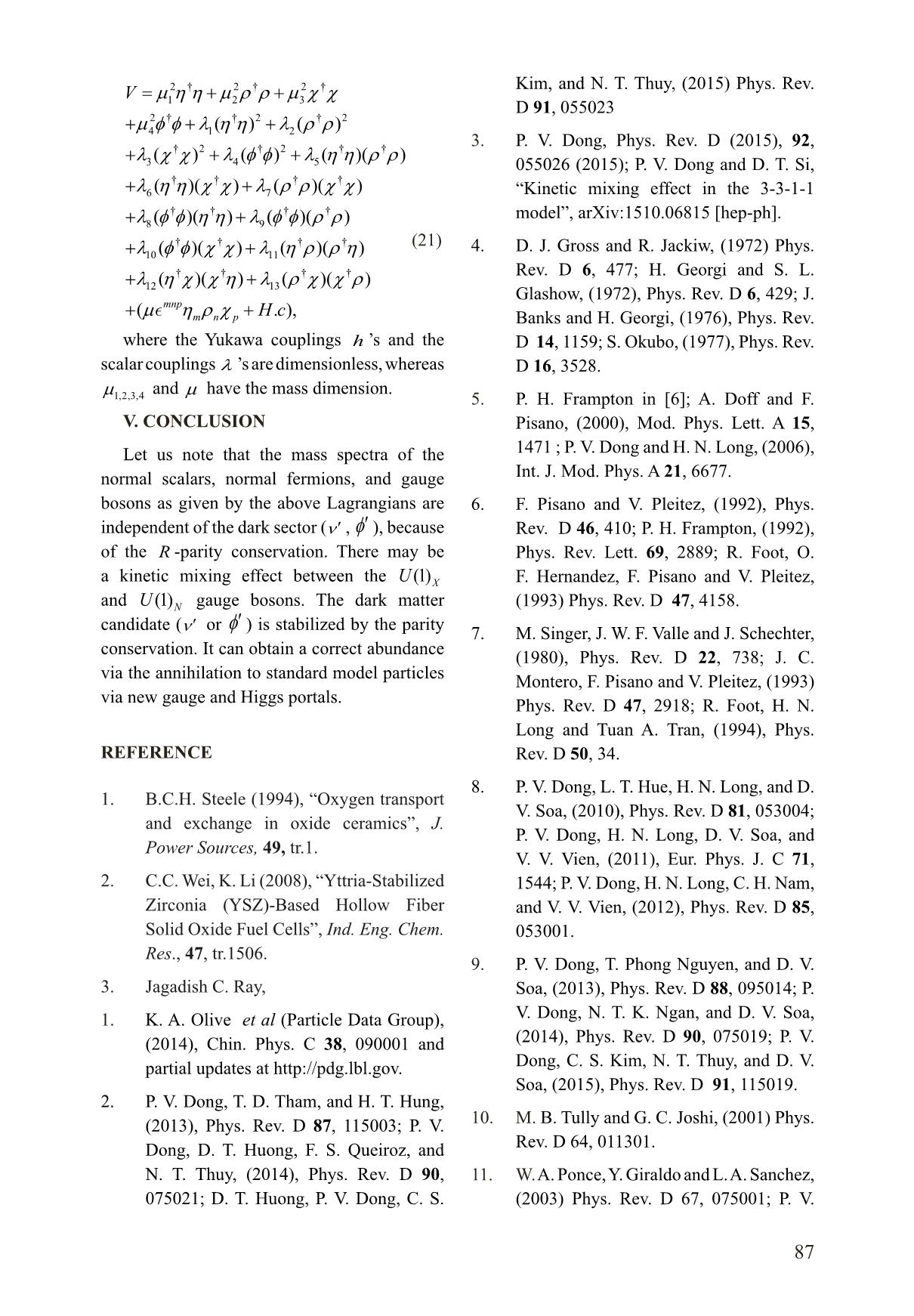
Trang 6
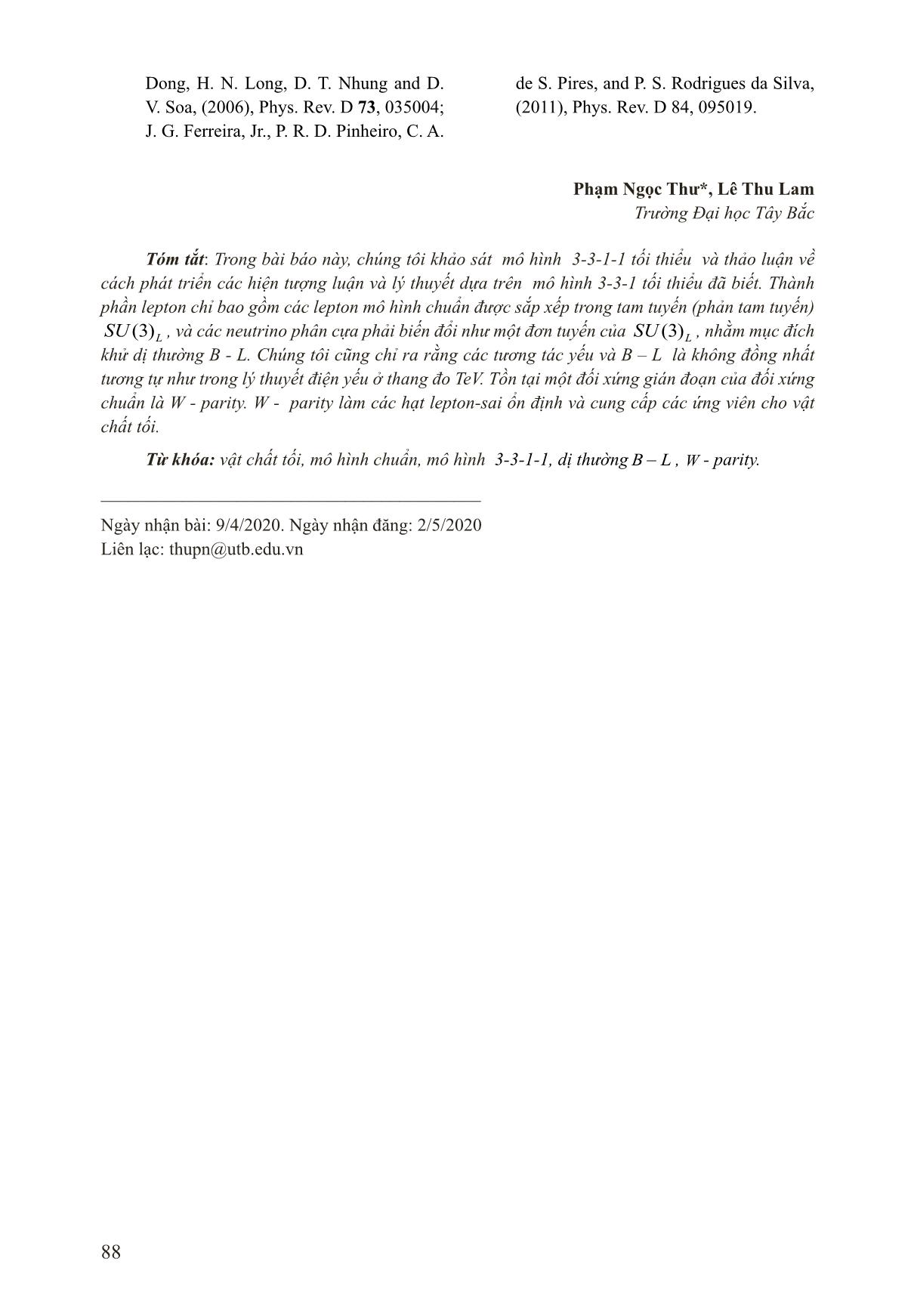
Trang 7
Tóm tắt nội dung tài liệu: Ark matter in minimal 3-3-1-1 model
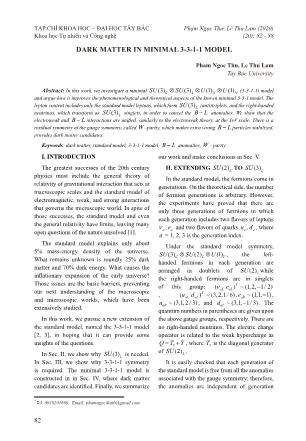
TẠP CHÍ KHOA HỌC – ĐẠI HỌC TÂY BẮC Phạm Ngọc Thư, Lê Thu Lam (2020)
Khoa học Tự nhiên và Công nghệ (20): 82 - 88
DARK MATTER IN MINIMAL 3-3-1-1 MODEL
Pham Ngoc Thu, Le Thu Lam
Tay Bac University
Abstract: In this work, we investigate a minimal SU(3)C⊗ SU (3) LXN ⊗⊗ U (1) U (1) (3-3-1-1) model
and argue how it improves the phenomenological and theoretical aspects of the known minimal 3-3-1 model. The
lepton content includes only the standard model leptons, which form SU (3) L (anti)triplets, and the right-handed
neutrinos, which transform as SU (3) L singlets, in order to cancel the BL− anomalies. We show that the
electroweak and BL− interactions are unified, similarly to the electroweak theory, at the TeV scale. There is a
residual symmetry of the gauge symmetry, called W -parity, which makes extra wrong BL− particles stabilized,
provides dark matter candidates.
Keywords: dark matter, standard model, 3-3-1-1 model, BL− anomalies, W - parity .
I. INTRODUCTION our work and make conclusions in Sec. V.
The greatest successes of the 20th century II. EXTENDING SU (2)L TO SU (3) L
physics must include the general theory of
In the standard model, the fermions come in
relativity of gravitational interaction that acts at
generations. On the theoretical side, the number
macroscopic scales and the standard model of
of fermion generations is arbitrary. However,
electromagnetic, weak, and strong interactions
the experiments have proved that there are
that governs the microscopic world. In spite of
only three generations of fermions in which
those successes, the standard model and even
each generation includes two flavors of leptons
the general relativity have limits, leaving many
ν , e and two flavors of quarks ud, , where
open questions of the nature unsolved [1]. aa aa
a = 1, 2, 3 is the generation index.
The standard model explains only about
Under the standard model symmetry,
5% mass-energy density of the universe.
SU(3)⊗⊗ SU (2) U (1) , the left-
What remains unknown is roundly 25% dark C LY
handed fermions in each generation are
matter and 70% dark energy. What causes the
arranged in doublets of SU (2) while
inflationary expansion of the early universe? L
the right-handed fermions are in singlets
Those issues are the basic barriers, preventing T
of this group: (ν aLe aL ) ~ (1, 2,− 1 / 2)
our next understanding of the macroscopic T
, (ud ) ~ (3, 2,1 / 6) , e ~ (1,1,− 1) ,
and microscopic worlds, which have been aL aL aR
u ~ (3,1, 2 / 3) , and d ~ (3,1,− 1 / 3) . The
extensively studied. aR aL
quantum numbers in parentheses are given upon
In this work, we pursue a new extension of the above gauge groups, respectively. There are
the standard model, named the 3-3-1-1 model no right-handed neutrinos. The electric charge
[2, 3], in hoping that it can provide some operator is related to the weak hypercharge as
insights of the questions. QT=3 + Y, where T3 is the diagonal generator
of SU (2)L .
In Sec. II, we show why SU (3) L is needed.
In Sec. III, we show why 3-3-1-1 symmetry It is easily checked that each generation of
is required. The minimal 3-3-1-1 model is the standard model is free from all the anomalies
constructed in in Sec. IV, where dark matter associated with the gauge symmetry; therefore,
candidates are identified. Finally, we summarize the anomalies are independent of generation
*Tel: 0918201669, Email: phamngocthutb@gmail.com
82
number which the model presents. In addition,
3 transforms as 3 under SU (3) L . The item
the chiral anomaly [SU (2)L ] always vanishes
without depending on any chiral fermion content “minimal” means that the lepton triplets are
of the model since the anomaly contribution constructed from just lepton doublets and
singlets of the standard model (no extra particle
Aijk = Tr[{ TTi , j } T k ]= 0 for any chiral fermion
representation T (i = 1, 2, 3) of SU (2) . The is required for the lepton triplets). Here, we
i L c cc
have denoted eeRR≡=() () e L ( c indicates
SU (2)L is a safe group because its anomaly is
trivial. to charge conjugation) which implies that all
the components of triplets are left-handed as a
However, for an extension with higher chiral consequence of the commutation between the
=
symmetry such as SU() N ( N 3, 4, 5 ), the space-time and gauge symmetries.
corresponding Aijk generally does not vanish
[4]. This subsequently gives a constraint on The SU (3) L self-anomaly is cancelled if
the fermion content of the new model to cancel the number of fermion triplets equals to that
the anomaly. Indeed, the minimal extension, of fermion antitriplets. Therefore, the first
two generations of quarks can be arranged
SU (2)L to SU (3) L , provide a solution to the
issue of three fermion generations observed in in antitriplets while the third generation of
− T *
the nature (because the generation nu ... (3) L L
generators). It is easily checked that model case). We can show this explicitly by
considering for a lepton triplet, therefore the
[Q, T± iT] =±±≠ ( T iT ) 0,
12 12 BL− charge is given by BL− = diag(−1, −1,
[Q, T45±= iT] ( T 45 ±≠ iT ) 0, (1) 1). We have nonzero commutations:
[Q, T67±= iT] 2( T 67 ±≠ iT ) 0.
[B− L, T45 ±= iT] 2( T 45 ±≠ iT ) 0,
The non-closed algebras can be deduced
[B− L, T67 ±= iT] 2( T 67 ±≠ iT ) 0. (3)
from the fact that in order for Q to be some
Also, if BL− is algebraically
generation of SU (3) L , we have a linear
closed with , it is a linear combination
combination Q= xT and thus TrQ = 0 , which SU (3) L
ii −=
is invalid for right-handed quark singlets such of Ti generators, B L aTii and thus Tr
(BL−= )0. It is incorrect for a lepton
as uR and dR as well as left-handed quark
triplets and antitriplets. triplet, Tr(BL−=− ) 1, thus the algebras are
non-closed. Let us introduce a new Abelian
In other words, the Q and T by themselves
i charge N so that BL− is a residual charge
do not make a symmetry under which our
of SU(3)⊗ U (1) , i.e. B−= L a T + bN .
theory based on is manifest. Therefore, to have LN ii
Acting BL− on a lepton triplet, we have
a closed algebra, we must introduce at least a 4
new Abelian charge X so that Q is a residual BL−=− T8 + N. (4)
3
⊗
symmetry of closed group SU(3)LX U (1) , Let us note that the N cannot be identified as
= +
i.e. Q xii T yX . The coefficients xyi , can X since they are generally different for right-
be obtained when Q acts on a lepton triplet, for handed fermion singlets, even for left-handed
example, to yield fermion triplets. They are independent charges.
−
QT=−+383. T X (2) Similarly to the case of Q , BL and N are
gauged charges since T is a gauged charge. This
The weak rhyperchage can be identified as 8
is a consequence of non-commuting BL− with
Y=−+3 TX8 . If Q is an exact symmetry of
SU (3) L which is unlike the standard model. In
the SU (3) L theory, the introduction of X is
necessary since in the theory’s Lagrangian we other words, the theory is only consistent if it
contains at least the SU(3)LXN⊗⊗ U (1) U (1)
can always find a conserved symmetry U (1) X
so that Q is obtained by the above relation is gauge symmetry. Let us remind the reader that
also conserved. By contrast, a violation in X the minimal 3-3-1 model always conserves
BL− . Therefore, in its Lagrangian we can find
leads to the violation in Q . Since Ti are gauged
charges, the Q and X must be gauged charges. a conserved Abelian charge N so that BL−
The gauging of Q is a consequence of non- is related to as given above. The gauging of
BL− and N as a necessary requirement for
commuting between Q and SU (3) L . In other
words, the theory is only consistent if it contains a consistent theory were neglected.
at least the SU(3)LX⊗ U (1) gauge symmetry. In summary, the chiral symmetry theory
This is like a similar one in the standard model.
of weak interaction SU (3) L contains in it
It is evident that BL− is a good two conserved non-commuting charges, Q
symmetry. In the standard model and minimal similarly to the standard model case while
3-3-1 model, it is an exact symmetry. We have BL− characteristically for the new extension.
not observed the violation of BL− on the The theory is only manifest or self-consistent
experimental side. Therefore, the conservation if it works with a closed algebra based on the
of B−L is naturally supposed in this theory [10]. following gauge symmetry:
84
handed counterparts, which are unlike ordinary
SU(3)C⊗ SU (3) LXN ⊗⊗ U (1) U (1) , (5)
quarks. The ν R fields are necessarily included
which is named 3-3-1-1 symmetry as just to cancel the BL− anomalies. We see that
the component groups mean. A model based on ν R is not a sterile particle since it has BL−
it is called 3-3-1-1 model, a self-contained and interaction, which is unlike that in the ordinary
unified theory of strong, electroweak and BL− seesaw extension of the standard model. For the
interactions. It is noteworthy that even for the phenomenological purpose, we also introduce a
typical 3-3-1 models [6–8], we can always find variant of it, called ν ′ , which has only BL−
′
a conserved symmetry U (1) N so that BL− (abnormal) charge, e.g. ν ~ (1,1, 0, 2) . This
is the residual charge of SU(3)LN⊗ U (1) . particle is a standard model singlet, vectorlike,
And, this charge has to be gauged since T8 is and often neglected. However, its presence may
gauged. The 3-3-1 model is only self-consistent imply to the simplest case of a fermionic dark
if we additionally include the gauge symmetry matter.To break the 3-3-1-1 gauge symmetry
U (1) N [2, 3]. Otherwise, the 3-3-1 models must and generate the masses in a correct way, we
contain the interactions which explicitly violate introduce the following scalars,
the lepton number. In fact, the 3-3-1 models η 0
are only survival if the lepton symmetry is 1
ηη= −
an approximate symmetry, which have been 2 ~ (1, 3, 0, 2 / 3),
η +
studied in [9, 11]. 3
IV. PARTICLE CONTENT, R-PARITY +
ρ1
AND TOTAL LAGRANGIAN 0
ρρ= 2 ~ (1, 3,1, 2 / 3),
Under the 3-3-1-1 gauge symmetry, the ρ ++
3
fermion representations of the model are given
−
as χ
1
ν aL −−
χχ=2 ~ (1, 3, −− 1, 4 / 3), (10)
ψ ≡−e ~ (1, 3, 0, 1/ 3) ,
aL aL 0
c χ
e ν aR ~ (1,1, 0,− 1), 3
aR (6)
φ ~ (1,1, 0, 2). (11)
dα L
≡−* − − Here, the scalar triplets are given similarly
QuααLL ~ (3,3 , 1/3, 1/3),
to the minimal 3-3-1 model, while φ is
Jα L
necessarily included to break U (1) N totally
u3L as well as providing the masses for the right-
≡ handed neutrinos. The electrically-neutral
Q33LL d ~ (3, 3, 2 / 3,1) , (7)
scalar components can develop VEVs as
J3L
u 0
ud~ (3,1, 2 / 3,1 / 3), ~ (3,1,− 1 / 3,1 / 3) (8) 1 1
aR aR 〈η 〉= 0,〈ρ 〉= v ,
2 2
0 0
Jα R ~ (3,1,−− 4 / 3, 5 / 3), J3R ~ (3,1, 5 / 3, 7 / 3). (9)
0
The quantum numbers in parentheses are 1
1 〈φ〉= Λ , (12)
defined upon the 3-3-1-1 groups, respectively. 〈χ 〉= 0,
2 2
The X and N charges have been obtained, based w
on the relations (2), (4) and the known BL−
which can be given from the scalar potential
and Q values of ordinary particles. Let us note
minimization. For the phenomenological
that the exotic quarks J have anomalous Q and
a purpose, we also include a standard-
BL− charges as given by the last two numbers
model singlet scalar as a variant of φ
in the corresponding parentheses for their right-
, e.g. φ′ ~ (1,1, 0,1) , which has only BL−
85
(abnormal) charge and cannot develop a VEV 3-3-1-1 gauge symmetry, when including the
due to a reason discussed below. Furthermore, spin one. Remark: (i) all the particles that are
this scalar singlet can couple the fermion singlet those of the minimal 3-3-1 model, U (1) N gauge
ν ′ to the right-handed neutrinos, and all them boson, φ , and ν R acting as the essential blocks
′
have U (1) N interactions too. The φ field may for a self-consistent theory are R -even (they
be the simplest case of a scalar dark matter. have normal BL− number or only differ from
The 3-3-1-1 gauge symmetry is broken that value by even units), whereas (ii) the most
trivial particles, the singlet fermion (ν ′ ) and the
down to SU(3)⊗⊗ U (1) U (1)
C Q BL− φ′
due to the VEVs of η , ρ and χ . This singlet scalar ( ), are R -odd, assumed that
−
breaking process undergoes two stages. they have wrong (abnormal) BL number.
The first stage is the 3-3-1-1 symmetry to This stuff of particles can contribute dark
matter, and the candidate is either ν ′ or φ′ if it
SU(3)C⊗ SU (2)L ⊗⊗ U (1) Y U (1) BL−
due to w . The second stage is is lightest between the two.
SU(3)C⊗ SU (2)L ⊗⊗ U (1) Y U (1) BL− to The total Lagrangian, up to the gauge mixing
SU(3)C⊗⊗ U (1) Q U (1) BL− due to uv, . Note and ghost terms, is given by
that uv, also break the N charge to BL− , like µµ†
=∑∑Fiγ Dµµ F + ( D S )( D S )−+ V Y
w . Simultaneously, the VEV of φ breaks the FS
N or BL− symmetry to a discrete symmetry,
denoted by P , UP(1) → . Above, Q 1 µν µν µν µν
BL− −(Giiµν G + A iiµν A ++ BBµν CCµν ), (15)
is always conserved, responsibly for the 4
where F and S indicate to the fermion
electromagnetic interaction, while BL− must
multiplets and scalar multiplets, respectively.
be broken (down to P ) because this kind of
The covariant derivative takes the form,
interaction should be short range, and its gauge
D=∂+ ig t G + igT A
boson get a large enough mass to escape from µµsi i µ i i µ (16)
++
the detection. In summary, the gauge symmetry igXN XBµµ ig NC ,
of the theory is broken as
uvw,, ,Λ where (,tTXNii , , ), (gs ,, gg XN , g ), and
⊗ ⊗⊗ → (13)
SU(3)C SU (3) LXN U (1) U (1) (,Gii A ,,) BC denote the generators, gauge
SU(3)CQ⊗⊗ U (1) P . coupling-constants, and gauge bosons of the
3-3-1-1 groups, respectively. The field strength
Here, P is obtained by the reduction process:
tensors are
SU(3)LN⊗→ U (1) U (1) BL− → P .
Giµν=∂−∂− µ Gi ν ν G i µ gf s ijk G jµ G k ν , (17)
First, BL− transforms component fields by
iα () BL− Aiµν=∂−∂− µ Ai ν ν A i µ gf ijk A jµ A k ν , (18)
Ue()α = , where BL−=−(4 / 3) T8 + N
and α is a transforming parameter. Next, P Bµν=∂ µ B ν −∂ ν BC µ,, ∂ µν =∂ µ C ν −∂ ν C µ (19)
is a BL− subgroup that conserves the φ where f is the fine structure constant of
i2α ijk
vacuum, i.e. U ()α Λ=Λ, with Ue()α = SU (3) group. The Yukawa Lagrangian and
i2α
for φ . We have e =1, thus απ= k , for scalar potential are obtained, respectively, by
k =0, ±± 1, 2, The discrete symmetry is ννc
kBL()− =hhψ ην + ′ ν ν φ
P= Uk(π ) = ( − 1) . Considering only Y ab aL bR ab aR bR
3(BL− ) e mnp c
the solution, k = 3, it becomes P =( − 1) +hab (ψψη aL )( m bL )( n ) p
. The angular momentum conservation implies JJ*
++hQ33 3LRχχ J 3 hαβ Q α L J β R (20)
that the spin parity (− 1) 2s is always conserved
++udηρ
and unbroken. Therefore, P can be rewritten in hQ33a L u aR hQ 33 a L d aR
= − 3(BL−+ ) 2 s du**
a convenient form, P ( 1) , which is ++hQααa Lηρ d aR hQ αα a L u aR + Hc.,
commonly called R -parity. Hence, the R -parity
as studied in SUSY is interpreted as a residual
86
2† 2 † 2 † Kim, and N. T. Thuy, (2015) Phys. Rev.
V =++µηη µρρ µχχ
12 3 D 91, 055023
2† † 2 † 2
++µφφ41 λ() ηη + λ 2 ( ρ ρ )
3. P. V. Dong, Phys. Rev. D (2015), 92,
+λ( χ† χ ) 2 ++ λ ( φφ †2 ) λ ( ηη † )( ρ † ρ )
3 45 055026 (2015); P. V. Dong and D. T. Si,
†† † †
++λ67( ηη )( χχ ) λ ( ρρ )( χχ ) “Kinetic mixing effect in the 3-3-1-1
†† † † model”, arXiv:1510.06815 [hep-ph].
++λ89( φφ )( ηη ) λ ( φφ )( ρρ )
†† † † (21)
++λ10 ( φφ )( χ χ ) λ11 ( η ρ )( ρη ) 4. D. J. Gross and R. Jackiw, (1972) Phys.
++ληχχηλ(†† )( ) ( ρχχρ †† )( ) Rev. D 6, 477; H. Georgi and S. L.
12 13 Glashow, (1972), Phys. Rev. D 6, 429; J.
++µmnp ηρχ
( mn p Hc. ), Banks and H. Georgi, (1976), Phys. Rev.
where the Yukawa couplings h ’s and the D 14, 1159; S. Okubo, (1977), Phys. Rev.
scalar couplings λ ’s are dimensionless, whereas D 16, 3528.
µ and µ have the mass dimension.
1,2,3,4 5. P. H. Frampton in [6]; A. Doff and F.
V. CONCLUSION Pisano, (2000), Mod. Phys. Lett. A 15,
Let us note that the mass spectra of the 1471 ; P. V. Dong and H. N. Long, (2006),
normal scalars, normal fermions, and gauge Int. J. Mod. Phys. A 21, 6677.
bosons as given by the above Lagrangians are 6. F. Pisano and V. Pleitez, (1992), Phys.
independent of the dark sector (ν ′ , φ′ ), because Rev. D 46, 410; P. H. Frampton, (1992),
of the R -parity conservation. There may be Phys. Rev. Lett. 69, 2889; R. Foot, O.
a kinetic mixing effect between the U (1) X F. Hernandez, F. Pisano and V. Pleitez,
and U (1) N gauge bosons. The dark matter (1993) Phys. Rev. D 47, 4158.
candidate (ν ′ or φ′ ) is stabilized by the parity
7. M. Singer, J. W. F. Valle and J. Schechter,
conservation. It can obtain a correct abundance (1980), Phys. Rev. D 22, 738; J. C.
via the annihilation to standard model particles Montero, F. Pisano and V. Pleitez, (1993)
via new gauge and Higgs portals. Phys. Rev. D 47, 2918; R. Foot, H. N.
Long and Tuan A. Tran, (1994), Phys.
REFERENCE Rev. D 50, 34.
8. P. V. Dong, L. T. Hue, H. N. Long, and D.
1. B.C.H. Steele (1994), “Oxygen transport
V. Soa, (2010), Phys. Rev. D 81, 053004;
and exchange in oxide ceramics”, J.
P. V. Dong, H. N. Long, D. V. Soa, and
Power Sources, 49, tr.1.
V. V. Vien, (2011), Eur. Phys. J. C 71,
2. C.C. Wei, K. Li (2008), “Yttria-Stabilized 1544; P. V. Dong, H. N. Long, C. H. Nam,
Zirconia (YSZ)-Based Hollow Fiber and V. V. Vien, (2012), Phys. Rev. D 85,
Solid Oxide Fuel Cells”, Ind. Eng. Chem. 053001.
Res., 47, tr.1506.
9. P. V. Dong, T. Phong Nguyen, and D. V.
3. Jagadish C. Ray, Soa, (2013), Phys. Rev. D 88, 095014; P.
1. K. A. Olive et al (Particle Data Group), V. Dong, N. T. K. Ngan, and D. V. Soa,
(2014), Chin. Phys. C 38, 090001 and (2014), Phys. Rev. D 90, 075019; P. V.
partial updates at Dong, C. S. Kim, N. T. Thuy, and D. V.
Soa, (2015), Phys. Rev. D 91, 115019.
2. P. V. Dong, T. D. Tham, and H. T. Hung,
(2013), Phys. Rev. D 87, 115003; P. V. 10. M. B. Tully and G. C. Joshi, (2001) Phys.
Dong, D. T. Huong, F. S. Queiroz, and Rev. D 64, 011301.
N. T. Thuy, (2014), Phys. Rev. D 90, 11. W. A. Ponce, Y. Giraldo and L. A. Sanchez,
075021; D. T. Huong, P. V. Dong, C. S. (2003) Phys. Rev. D 67, 075001; P. V.
87
Dong, H. N. Long, D. T. Nhung and D. de S. Pires, and P. S. Rodrigues da Silva,
V. Soa, (2006), Phys. Rev. D 73, 035004; (2011), Phys. Rev. D 84, 095019.
J. G. Ferreira, Jr., P. R. D. Pinheiro, C. A.
Phạm Ngọc Thư*, Lê Thu Lam
Trường Đại học Tây Bắc
Tóm tắt: Trong bài báo này, chúng tôi khảo sát mô hình 3-3-1-1 tối thiểu và thảo luận về
cách phát triển các hiện tượng luận và lý thuyết dựa trên mô hình 3-3-1 tối thiểu đã biết. Thành
phần lepton chỉ bao gồm các lepton mô hình chuẩn được sắp xếp trong tam tuyến (phản tam tuyến)
SU (3) L , và các neutrino phân cựa phải biến đổi như một đơn tuyến của SU (3) L , nhằm mục đích
khử dị thường B - L. Chúng tôi cũng chỉ ra rằng các tương tác yếu và B – L là không đồng nhất
tương tự như trong lý thuyết điện yếu ở thang đo TeV. Tồn tại một đối xứng gián đoạn của đối xứng
chuẩn là W - parity. W - parity làm các hạt lepton-sai ổn định và cung cấp các ứng viên cho vật
chất tối.
Từ khóa: vật chất tối, mô hình chuẩn, mô hình 3-3-1-1, dị thường BL− , W - parity.
__________________________________________
Ngày nhận bài: 9/4/2020. Ngày nhận đăng: 2/5/2020
Liên lạc: thupn@utb.edu.vn
88File đính kèm:
 ark_matter_in_minimal_3_3_1_1_model.pdf
ark_matter_in_minimal_3_3_1_1_model.pdf

